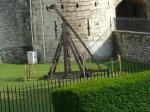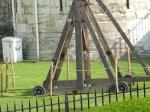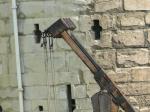Moyen Age Trébuchet à Traction de Crabbe 1319 Londres
English Translation
 |
| Osprey |
Historique Voir ICI
History Click HERE
Cet engin est une reproduction d'un trebuchet lancant des "missiles" utilisé par les Écossais qui défendent Berwick contre les Anglais en 1319
Avant le roi Edouard Ier d'Angleterre a commencé à s'immiscer dans les affaires écossais, Berwick-upon-Tweed était une ville frontière prospère du le royaume d'Écosse. Capturée par les Anglais en 1296, ses fortifications ont été renforcées rapidement mais elles sont restées modestes.
En 1318, les Ecossais reprennent Berwick et l'année suivante, les troupes d'Edouard II assiègent la cité éfin de la reprende . La ville subit un siège de 10 jours. John Crabbe, un ingénieur flamand militaire au service de l'Ecossais, avait en charge les aspects techniques de la défense.
À un moment donné il a fait confectionné des engins incendiaires avec du bois, goudron, et de soufre liés avec des cerceaux de fer . Ces projectiles sont ensuite lancés par une Grue qui se transforme ainsi en trébuchet à traction sur le toit blindé utilisé par les Anglais pour protéger les mineurs qui tentent de saper les murs.
Ce toit avait déjà été endommagée par les Ecossais les projectiles incendiaires rendent la structure vulnérables à un incendie.
On ne sait ou cetre grue était placée pour envoyer avec précision les projectiles A une certaine distance de la base du mur, ou sur le parapet même
Mais cette machine joua son jeu car le siège anglais de Berwick a été levé.
This device was a reproduction form the Crane to Drop Missiles used by Scots defending Berwick Against the English in 1319
Before King Edward I of England started to interfere in Scottish affairs, Berwick-upon-Tweed was a prosperous frontier town within the Kingdom of Scotland. Seized by the English in 1296, its fortifications were hurriedly strengthened but they remained rather low and not very strong.
In 1318 the Scots regained Berwick and the following year the troops of Edward II tried to retake it during a 10-day siege. John Crabbe, a Flemish military engineer in the service of the Scots, was in charge of the technical aspects of the defence. At one point he made incendiary bales of wood, tar, pitch and brimstone bound with iron hoops which were then dropped by a crane onto the armoured roof used by the English to protect miners trying to undermine the walls.
This roof had already been damaged by the Scots’ stone-throwing machine, perhaps exposing the timbers and making them vulnerable to incendiary attack.
The purpose of Crabbe’s crane was to place incendiary bales accurately at some distance from the base of the wall, but the crane itself would almost certainly have been on the ground inside the wall, rather than being on the parapet or walkway.
It proved a success and the English siege of Berwick failed.
Voir Aussi Autre Photoscope See Also Other Walk Around
Trébuchet à Contrepoids
 |
| Trébuchet à contrepoids (Osprey) |







.JPG)

.JPG)



